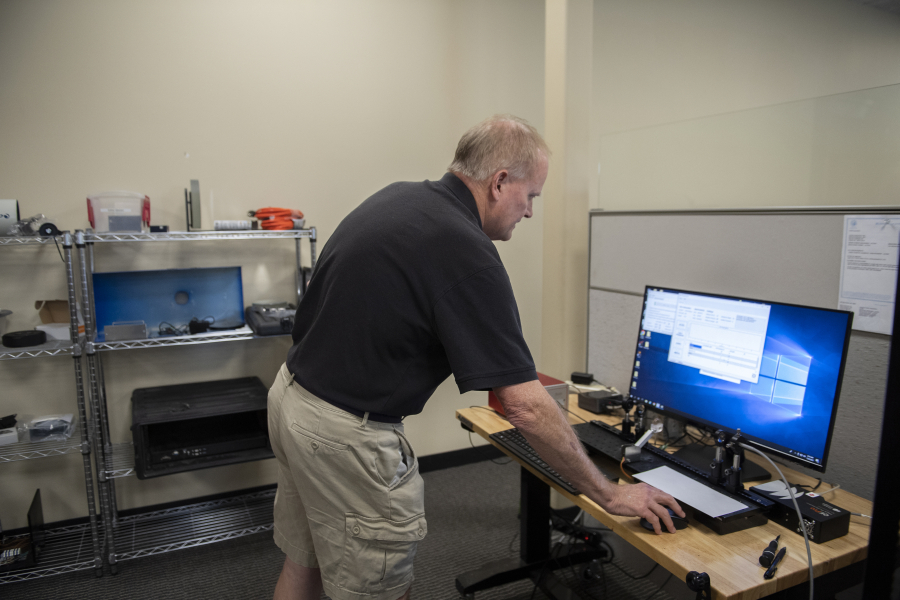CAMAS — When Don Gamiles discovered a former Kmart in Northeast Portland was burning early July 19, he and a colleague loaded every piece of air monitoring technology they could and bolted from their Camas office.
“We want to find pollution,” said Gamiles, founder and president of Argos Scientific, an air monitoring and data collection company. “We run toward it.”
His goal was to set up equipment in the Parkrose neighborhood to gather data and generate a health impact analysis for surrounding areas. As they approached the fire, his colleague Hailey Gebhart, an Argos Scientific data analyst, described the air as filled with an odor of smoke mixed with “things that aren’t supposed to burn.”
The fire destroyed the building and spread ash and debris throughout surrounding neighborhoods. The Oregon Department of Environmental Quality later found the presence of asbestos in some of the old store’s ruins.
Using Argos Scientific’s equipment, Gamiles and Gebhart observed a spike in air particulates across the street at Parkrose High School, even though it was not downwind from the fire. At an apartment complex adjacent to the burned building, pollution was even worse.
“We were only comfortable there for a couple of hours, but (these) are apartment complexes where people spend their lives,” Gebhart said.
The Kmart fire only intensified Parkrose-Argay residents’ pre-existing concerns, which were borne from plans by industrial property giant Prologis to transform the old store into a shipping warehouse. Locals contend the development would increase traffic and, subsequently, further pollute an already under-served and overburdened community.
The Parkrose project is a first for Argos Scientific in the Pacific Northwest and only made possible because of Gamiles’ history with the neighborhood — he’s a Parkrose High graduate. Argos Scientific’s projects are primarily in Africa, the Middle East and U.S. states that regulate air pollution, such as California and Colorado.
Northeast Portland is the exception, at least until more local and state government agencies request the company’s expertise, he said.
Before the fire, Argos Scientific partnered with the Parkrose School District and Parkrose Argay Opportunity Coalition to implement a program to monitor air quality before, during and after Prologis’ planned development. Once equipment is fully installed by mid-August, real-time data will appear on a community website and, eventually, be incorporated into a science curriculum for the school district.
“If you can raise awareness within the community and educate them, that’s when this stuff will really take off,” Gamiles said, later speaking to the project’s educational component. “Kids just soak this stuff up. It’s amazing what they’re capable of doing.”
Cutting-edge tech
Argos Scientific’s Camas office looks like a giant science experiment.
Important-looking metal boxes varying in size, shape and color fill most shelves and tabletops. Argos Scientific buys these tools, then integrates components to make a cohesive platform for monitoring air. Each box serves a specific purpose, whether it’s detecting black carbon – a harmful particulate associated with diesel emissions – or sulfur dioxide and nitric oxides.
Argos Scientific partners with UCLA’s Atmospheric and Oceanic Sciences Department, whose pollution detection research powers the company’s equipment. The company’s technology meets the Federal Equivalent Method, a system that maintains consistency in sample collection and analysis.
Much of what Argos Scientific is working on will be obsolete within a few years, leading the company to search for innovative means of tracking air pollution, Gamiles said.
The company’s “claim to fame” is an ultraviolet air monitoring system that beams light across a half-mile, quantifying any particulates that cross its path, he said. Currently, the firm is developing smart air monitoring equipment to recognize specific types of pollution – say, particulates coming from a fire versus diesel engines – and operate itself.
Gamiles said he was alarmed the Pacific Northwest doesn’t have more air monitoring projects, although admitted he wasn’t surprised due to states’ lack of air pollution regulations.
“The most important thing anybody can do is educate the public,” he said. “These are things that you should be concerned about. No one is doing that.”




